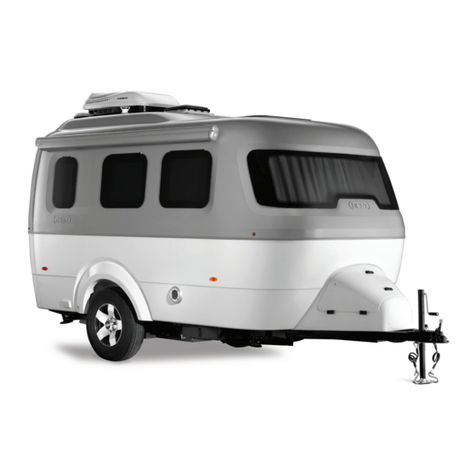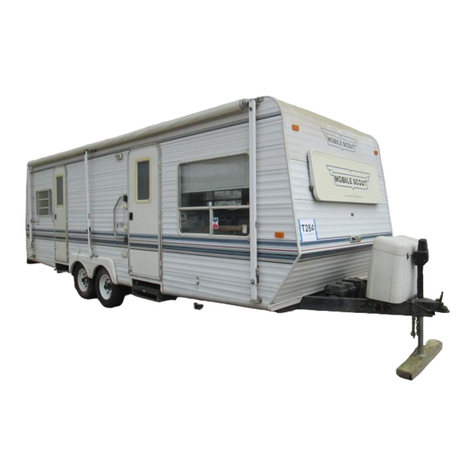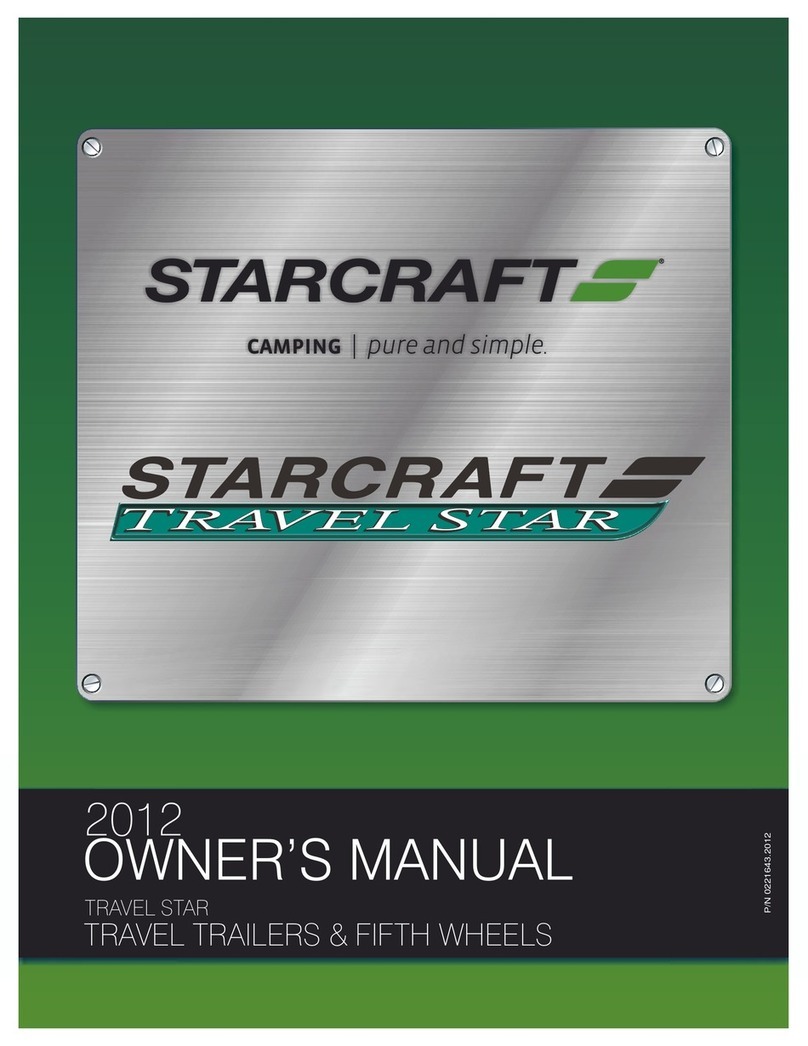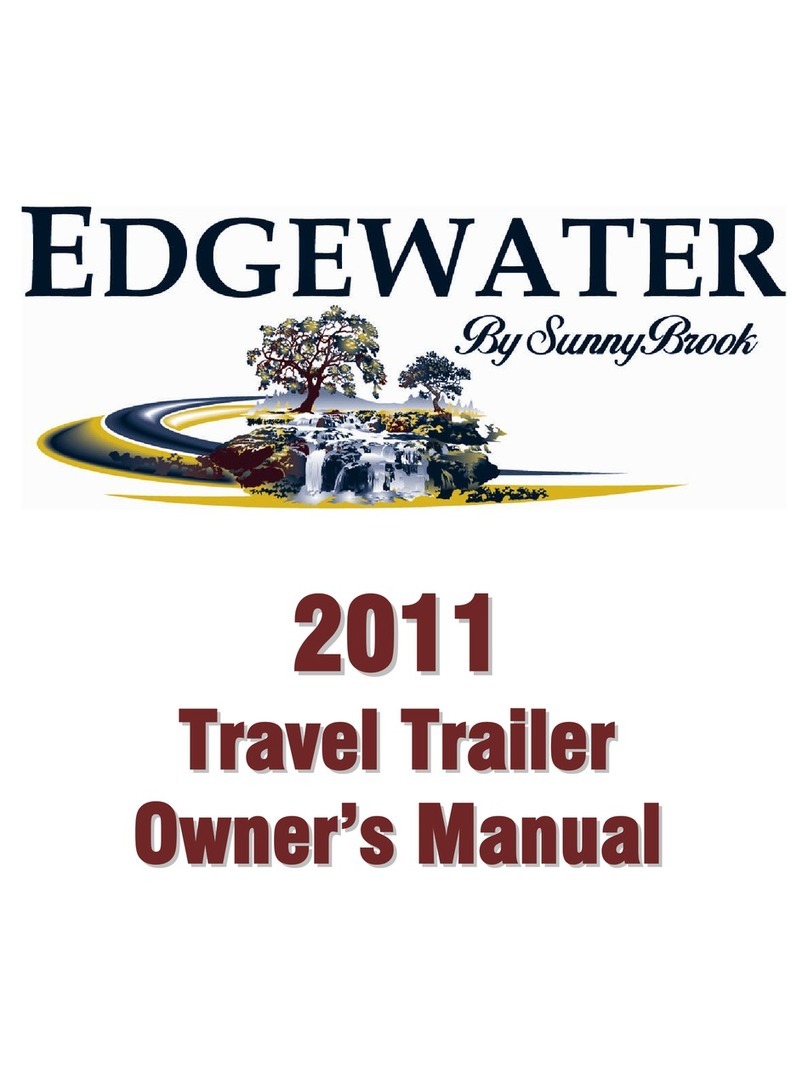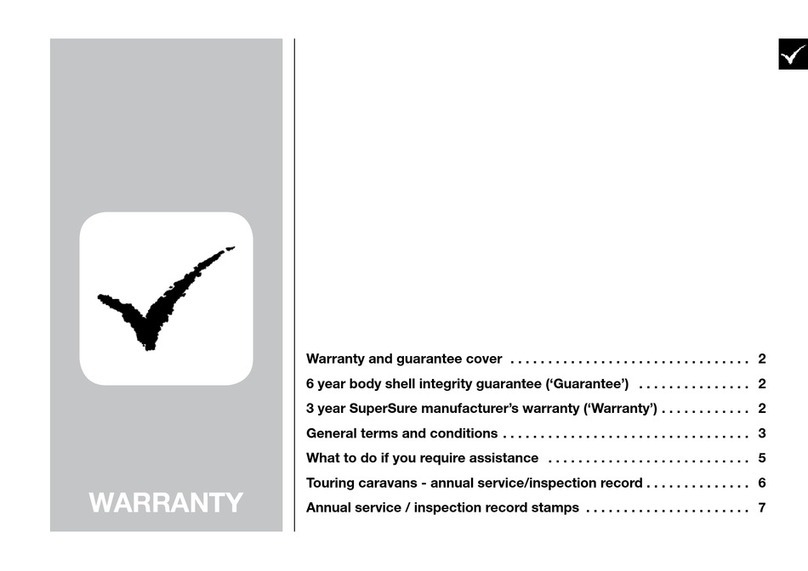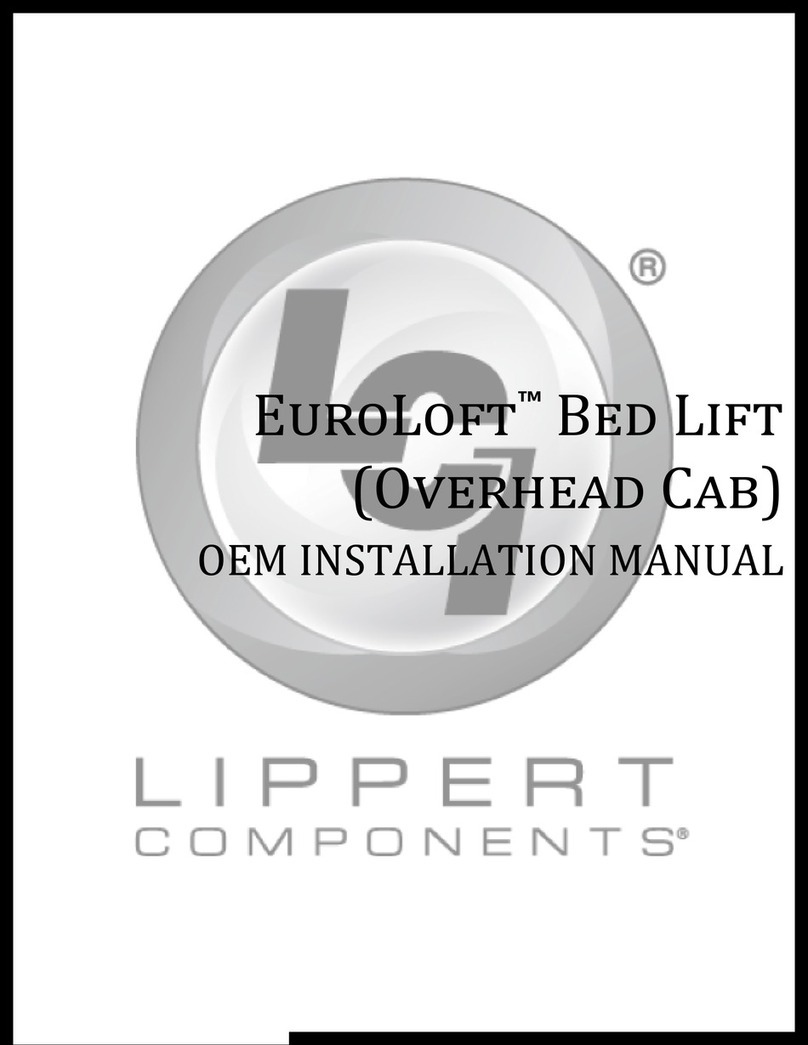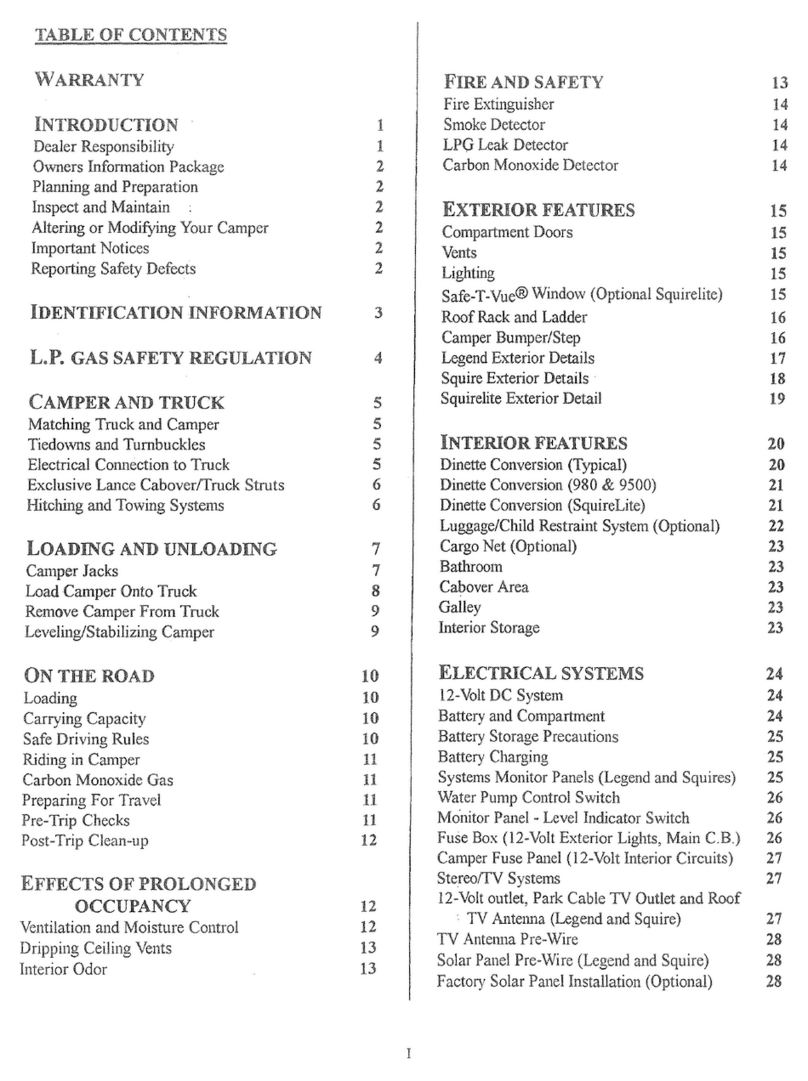Country Coach DynoMax Inspire 360 2008 User manual

2008
Inspire
360
Owner's
Guide:
Chassis
Revision A

Copyright
©
2007
Country
Coach
All rights reserved. No part
of
this manual may be reproduced
in
any form or
by
any means without prior written permission from Country Coach.

Foreword
Your Inspire motorcoach
is
built on a DynoMax chassis, designed and
constructed by the Country Coach team. Prior
to
coach assembly, the
completed chassis
is
thoroughly tested
in
our industry-leading DynoCenter to
verify peak chassis performance.
This Owner's Guide chassis section has been developed to provide you with
service information on the DynoMax chassis for the Inspire motorcoach. You
receive a general overview
of
chassis components and systems along with
maintenance, inspection, and diagnostic procedures.
Also, note that the Appendix includes maintenance intervals, fastener torque
recommendations, troubleshooting information, chassis specifications, the
maintenance schedule, and parts lists.
While information contained
in
this Owner's Guide
is
intended to establish
proper maintenance and inspection procedures, there may be times when
more detailed diagnostic and repair procedures will be required for chassis
components or systems. Technical manuals (such
as
CAT and Allison),
valuable engineering schematics, and the Heavy-Duty Tow Truck Directory are
available
in
your Coach Information
Kit.
You can obtain further operation and
service information by contacting Country Coach at 1-800-452-8015 or www.
countrycoach.com. Your local repair facility may also be of assistance.
Due
to constant product development and improvement, Country Coach
reserves the right to make product or specification changes without notice.
The components on your coach, their location, specifications, service or
maintenance requirements, may differ from those identified
in
this guide.
All
information, illustrations, and specifications contained
in
this manual are based
on the latest product information available at the time of publication.
®
COU
NTRY COACH
THE
WORLD'S
FINEST
MOTQRCOACHES
135
East
First Avenue • Junction
City,
Oregon 97448
541-998-9202
•
800-452-8015
www.countrycoach.com·[email protected]


Introduction
Important
Safety
Information
Service
and
Maintenance
Safety
Procedures
II
DynoMax
Chassis
III
Vehicle
Identification
Number
III
Maintenance
Schedule
III
Chassis
Inspection
III
Lubrication
Specifications
IV
Fuel
Specifications
V
Starting
Procedures
V
Normal-Weather Starting V
Cold-Weather Starting V
Starting After Extended Shutdown or
Oil
Change V
Engine Shut-Down
VI
Towing
and
Jacking
VI
Jacking Precautions
VI
Towing Precautions
VII
Tow
Truck Air Pressure Fitting
VII
Driveshaft Removal
VII
Torque
Values
VIII
Chassis
Bays
VIII
Chassis
Corrosion
Control
IX
Engine
Group
Engine
Description
1.1
Location
and
Mounting
1.1
Inspire
360
Table
of
Contents-Chassis
Chassis
toc.1

Inspire
360
Table
of
Contents-Chassis
Engine
Data
Plates
1.1
Operating
the
Engine
1.2
Engine
Protection
System
1.2
Drive
Belt
Maintenance
1.4
Fuel
System
1.5
Fuel
Requirements 1
.5
Fuel
Tank
1.5
Bacterial Contamination 1.6
Primary and Secondary
Fuel
Filters 1.6
Fuel
Transfer Pump
(C9)
1.8
Fuel
Lift Pump
(ISL)
1
.8
Air
Intake
System
1.8
Air Intake 1
.8
Turbocharger 1.9
Charge-Air Cooler 1.9
Charge-Air Cooler Maintenance 1.9
Engine
Exhaust
1.9
Diesel
Particulate Filter
(DPF)
1
.9
Engine
Brake
1.10
Precautions
on
Wet Pavement 1
.1
2
Descending a Grade 1.12
Cooling
System
1.12
Vent
Hoses 1.12
Water Pump 1.13
Thermostat 1.13
Surge
Tank
1.13
Radiator 1.13
Cooling
System
Inspection
and
Maintenance
1.13
Hoses 1.13
Coolant Checks and Replacement 1.13
Lubrication
System
1.14
Engine
Oil
1.14
Checking the Oil
Level
1.14
Adding Engine
Oil
1
.15
Oil
and Filter Change Intervals 1.15
Transmission
Group
toc.2
Chassis
Transmission
Precautions
2.1
Transmission
Operation
2.2
Electronic Control Unit 2.2
Reverse
(R)
2.2

Inspire
360
Table
of
Contents-Chassis
Neutral
(N)
2.2
Drive
(D)
2.2
Mode 2.2
Directional Arrow Symbols 2.2
Transmission Gear Recommendations 2.3
Parking the Motorcoach 2.3
3000
MH
Transmission
Diagnostics
2.3
3000
MH
Diagnostic Code Display Procedure 2.3
Clearing Active Codes
From
Memory 2.4
CX28
Transmission
Diagnostics
2.4
Check
Trans
Light 2.4
Transmission
Maintenance
and
Inspection
2.5
Breather Maintenance 2.5
Transmission
Fluid
2.5
Transmission
Fluid
Specifications 2.6
Fluid
Contamination 2.6
Fluid
Level
Check 2.7
Cold
Level
Fluid
Check 2.8
Hot
Level
Fluid
Check 2.9
CX28
Fluid
Level
Check with Transmission Shifter 2.9
Transmission
Fluid
Cooler 2.10
Driveshaft
2.10
Lubricating the Driveshaft and U-Joints 2.10
Axles,
Steering,
and
Suspension
Group
Axles
3.1
Brakes
3.1
Service Brakes
3.1
Parking Brake 3.2
Brake Inspection and Maintenance 3.2
Wheels
and
Tires
3.2
Tire
Inspection and Maintenance 3.2
Wheel
and Tire Balancing 3.3
Tire
Replacement 3.3
Front
and
Rear
Suspension
3.3
Height Control
Valves
3.3
Suspension Air Pressure 3.3
Front
Suspension
and
Steering
3.4
Front Alignment 3.4
Front-End Inspection 3.4
Chassis
toc.3

Inspire
360
Table
of
Contents-Chassis
toeA
Chassis
Rear
Suspension
3.5
Rear-End Inspection 3.6
Front
and
Rear
Suspension
Inspection
Checklist
3.6
30-Day Visual Inspection 3.6
1
,OOO-Mile
Inspection 3.7
5,OOO-Mile
Inspection 3.7
25,OOO-Mile
Inspection 3.7
Suspension Troubleshooting 3.8
Air
System
group
Air
Compressor
4.1
Air
Governor
4.1
Air
Tanks
4.1
Air
Dryer
4.3
Air Dryer Inspection 4.3
Air
Brake
Sending
Switches
4.3
Air
System
Safety
Equipment
4.3
Air
Line
Color
Code
4.4
Air
System
Maintenance
4.4
Hydraulic
System
Group
System
Operation
Introduction
5.1
Hydraulic
Fluid
Reservoir
5.1
Hydraulic Pumps 5.2
Hydraulic
Fluid
Cooler 5.2
Fan
Motor 5.3
Hydraulic
System
Maintenance
5.3
Hydraulic System Maintenance Tips 5.4
Power
Steering
System
5.4
Steering Gear 5.4
Power Steering System Inspection 5.4
Power Steering System Maintenance 5.5
Electrical
System
Group
Batteries
6.1
Battery Precautions
6.1
Battery Hazards 6.2
Battery Maintenance 6.2

Battery Troubleshooting 6.3
Jump-Starting Using a Booster Battery 6.3
Jump-Starting Using the Battery-Boost Switch 6.4
Battery Removal and Replacement 6.5
Charging
System
(Alternator)
6.5
Charging System Troubleshooting 6.5
Starting
System
6.6
Engine
Wiring
and
Sensors
6.6
Reader
Ports
6.6
Appendix
Maintenance
7.1
Periodic Maintenance Schedule
7.1
Commonly Replaced Items 7.7
Chassis Vendor List 7.8
Chassis Maintenance
Log
7.9
Chassis
Lubrication
7.11
Chassis Lubrication Points and Intervals
7.11
Chassis Lubrication
Fluid
Specifications 7.13
Chassis Grease Fitting Locations 7.14
Chassis
Torque
Values
7.14
12
Volt
Breaker
Terminal
Torque 7.14
Chassis Torque
Values
7.15
SAE
Bolt Torque
Values
7.19
Metric Bolt Torque
Values
7.20
Chassis
Systems
Troubleshooting
7.21
Wheel
Troubleshooting
7.21
Brake Component Troubleshooting 7.23
Power Steering Troubleshooting 7.25
Suspension Troubleshooting 7.27
Caterpillar
C9
Engine
Diagnostics 7.29
Cummins
ISL
Engine Diagnostics 7.29
ISL
Troubleshooting Procedures and Techniques 7.30
ISL
Engine
Fault
Code Information
7.31
Tire
Inflation
Pressure
7.34
Chassis
Winterization
7.34
Chassis
Specifications
7.35
Chassis
Parts
Section
7.36
Index
Inspire
360
Table
of
Contents-Chassis
Chassis
toc.S

Inspire
360
Table
of
Contents-Chassis
Notes:
toc.6
Chassis

Inspire
360
Introduction
Introduction
Important
Safety
Information
Service
and
Maintenance
Safety
Procedures
II
DynoMax
Chassis
III
Vehicle
Identification
Number
III
Maintenance
Schedule
III
Chassis
Inspection
III
Lubrication
Specifications
IV
Fuel
Specifications
V
Starting
Procedures
V
Towing
and
Jacking
VI
Torque
Values
VIII
Chassis
Bays
VIII
Chassis
Corrosion
Control
IX


INTRODUCTION
This
"Owner's
Guide
Chassis
Section"
contains operation, maintenance, and parts
identification information on the DynoMax motorcoach chassis for the Inspire
motorcoach models. Information on standard installed equipment and common
optional equipment
is
provided. Use this section when servicing and maintaining your
motorcoach chassis. Country Coach recommends that only professional mechanics
with motorcoach repair experience service your chassis.
Due to constant product development and improvement, Country Coach reserves
the right to make product or specification changes without notice. The components
on your coach, their location, specifications, service or maintenance requirements,
may differ from those identified
in
this manual.
All
information, illustrations, and
specifications contained
in
this manual
are
based upon the latest product information
available at the time of publication.
Service bulletins and manual revisions may be published to supplement, supersede,
or augment the information
in
this owner's guide. To keep your motorcoach
in
optimum running condition and to ensure coach longevity, follow the prescribed
maintenance schedules.
Please read this owner's guide before operating or servicing your motorcoach.
This manual contains important information about your chassis, such as safety
precautions, operating instructions, component and system specifications, and
scheduled maintenance requirements.
Important
Safety
Information
The service procedures recommended and described herein are effective methods
for performing service operations. Some of these service operations require the use
of tools designed specifically for that operation. Use these special tools when and
as
recommended.
Most accidents involving motorcoach operation and maintenance are caused by
failure to observe basic safety rules or precautions. Accidents and malfunctions can
be avoided by understanding and recognizing potentially hazardous situations at their
beginning. Preventative maintenance
is
the best way to avoid
an
accident.
Improper operation, lubrication, or maintenance of your motorcoach
is
dangerous.
Do not perform any lubrication or maintenance on the motorcoach until you read
and understand the instructions
in
this manual and the manuals provided by the
engine, transmission, and axle manufacturers.
Inspire
360
Introduction
Chassis
I

Inspire
360
Introduction
II
Chassis
Familiarize yourself with the warning, caution, and notice messages. These
highlighted messages alert you to situations, conditions or misapplications which
can result
in
personal injury, damage to equipment, or unsafe operating conditions.
These messages are not exhaustive. Country Coach could not possibly know and
evaluate
all
conceivable methods by which service might be done, and then advise
the service trade of
all
possible consequences of each method. Therefore,
Country Coach
has
not undertaken such a broad evaluation. Accordingly, anyone
who uses a service procedure or tool which
is
not recommended by Country Coach
must first be thoroughly satisfied that neither personal safety nor equipment integrity
will be jeopardized by the service method selected. Proper service and repair
is
critical to the
safe,
reliable operation of your motorcoach.
!
WARNING
Warns
the
driver
or
person
performing
service
of
certain
operations
or
misapplications
that
can
result
in
coach
damage,
serious
bodily
injury,
or
death.
!
CAUTION
Cautions
the
driver
or
person
performing
the
service
of
certain
operations,
functions,
or
misapplications
that
pose
danger
to
themselves,
their
passengers,
and/or
the
motorcoach.
!
NOTICE
Highlights
a
procedure
that
is
essential
for
proper
and
safe
operation
of
the
coach.
Service
and
Maintenance
Safety
Procedures
• Ensure the transmission
is
in
neutral.
• Apply the parking brake and stop the engine.
• Ensure the protection locks or controls are applied.
• Block or restrain the coach before performing maintenance or service.
• Disconnect the batteries whenever performing any maintenance or before
servicing the electrical system.
• When starting
an
engine after repairs have been made to the fuel system,
make provisions for shutting off the engine's intake air and/or fuel supply
(to
stop the engine)
in
case there
is
an
overspeed
on
start-up.
• Start the engine
only
from the driver's compartment. Never short across
the starter terminals or the batteries,
as
this could bypass the engine
neutral-start system and damage the electrical system.

DynoMax
Chassis
The DynoMax motorcoach chassis
(see
Figure
i.1)
is
a semi-monocoque construction
that integrates the two main frame tubes, the top
rail
assembly, bulkheads, and the
cab subassembly to lower the overall structural stress
level
throughout the coach.
The chassis also includes the coach engine/transmission assembly, driving controls,
and the suspensions.
Figure
i.1
DynoMax
Inspire
tag
chassis
Highlights include independent front suspension
(IFS)
for superior ride and handling,
heavy-duty rear
and
tag (optional) axles for maximum vehicle weight ratings, a
powerful diesel engine for power
on
demand, and multiple storage bays.
Vehicle
Identification
Number
The Vehicle Identification Number
(VIN)
is
the
legal
identification
or serial number of the coach
(see
Figure
i.2).
This number
appears
on
the vehicle certificate of the title, registration, and
on
a plate affixed to the outside of the driver-side frame just ahead
of the front wheel.
Maintenance
Schedule
Maintenance schedules are provided
in
the Appendix. By
following these maintenance schedules, you ensure optimum
coach performance.
Figure
i.2
Inspire
360
Introduction
Vehicle
identification
number
Chassis
Inspection
For your safety
and
for the proper maintenance of your motorcoach, inspect the
following items daily during periods of coach
use
and after periods of coach storage.
These inspections
are
most effective when
you
perform them before operating your
coach.
1 Visually
check
these items:
• Tires and wheels
• Wipers/washers
• Headlights
• Taillights
Chassis
III

Inspire
360
Introduction
IV
Chassis
•
Turn
signals
• Brake lights
• Backup lights
• Latches on compartments and awnings
2 Look under
the
coach for signs of fluid leaks.
3 Check:
•
Engine
oil: Keep to
full
mark on dipstick.
•
Coolant:
Should be visible through surge tank sight glass.
•
Transmission
fluid: Keep to
full
mark
on
dipstick.
•
Hydraulic
fluid: Keep to full mark
in
reservoir.
•
Fuel
filter/water
separator:
Drain water out.
•
Air
filter
minder:
Check for air flow restriction.
•
Air
tanks:
Drain condensation out of the air tanks.
•
Drive
belts:
Inspect for proper tension and condition.
•
Inspect
all
hoses,
lines,
and
fittings:
Hoses have a finite service life.
They should be inspected thoroughly at least every 500 operating hours or
annually. Look for cover damage or indications of twisted, worn, crimped,
brittle, cracked, or leaking lines. Hoses with their outer cover worn through
or with damaged metal reinforcement should be considered unfit for further
service.
Safety and maintenance checks may also be described
in
the original equipment
manufacturer's
(OEM)
manuals supplied with your coach. Consult these publications
to develop a comprehensive inspection and maintenance program.
Call
the
Country Coach service department at (541) 998-9202 or (800) 452-8015, 6:00 am
to
5:00 pm Pacific Time (Monday-Friday) and 7:00 am to 4:00 pm Pacific Time
(Saturday-Sunday) for further information.
Lubrication
Specifications
Various components of the motorcoach chassis must have proper lubrication
to
operate
as
designed. Refer to
Tables
7.4 and 7.5
in
the
Appendix
for lubrication
capacities, and specifications. For chassis grease fitting locations refer to
Figure
7.1
and
Table
7.6, and
pages
7.64 and 7.65,
in
the
Appendix.
In
addition to the tables
in
the Appendix, refer to the manufacturers' manuals that
accompany this manual (Caterpillar engine for example).

Fuel
Specifications
The use of ultra low sulphur diesel
(ULSD)
No.
20
fuel will result
in
optimum engine
performance. At operation temperatures below 32°F, acceptable performance
can be obtained by using blends
of
No.
20
and
No.1
D.
Your original equipment
manufacturer (OEM) engine manual can provide further fuel specification preference.
Starting
Procedures
Different ambient temperatures and driving conditions dictate different procedures for
starting the engine. The following inspection and starting procedures will preserve the
performance and longevity
of
your motorcoach. Refer
to
your Caterpillar or Cummins
OEM manual for detailed information and precautions.
Normal-Weather Starting
Follow
these
basic
starting
procedures
under
normal
driving
conditions:
1 Place the transmission
is
in
neutral
(N)
and apply the parking brake.
2
Turn
the ignition key switch to the start position. Release the ignition key
as soon
as
the engine starts.
3 If the engine fails to start within 30 seconds, release the ignition key switch
and wait two minutes to allow the starting motor to cool before attempting
to start the engine again.
!
CAUTION
Do
not
increase
engine
speed
unless
the
oil
pressure
gauge
indicates
normal.
If
oil
pressure
is
not
indicated
on
the
gauge
within
15
seconds,
stop
the
engine,
investigate,
and
correct
the
cause.
4 Once a normal engine
oil
pressure and air pressure are reached, the coach
may
be
operated at a light load
and
low speed. Check
all
gauges during
this period.
Cold-Weather Starting
To start the engine under frigid conditions, refer
to
your engine manual. Also, see
Chapter 2
in
the
House
section for location of the engine heater switch.
Starting After Extended Shutdown or
Oil
Change
Complete the following after each
oil
change, or after the engine has been shut
off for more than thirty days
to
make sure the engine receives the correct
oil
flow
throughout the lubricating
oil
system.
• Start the engine using the normal procedure and idle
until
oil
pressure
is
shown
on
the
oil
pressure gauge. If the
oil
pressure does not come
up
within 15 seconds, turn the engine off and repeat the normal start
procedure
until
oil
pressure
is
shown
on
the gauge.
Inspire
360
Introduction
Chassis
V

Inspire
360
Introduction
VI
Chassis
Engine
Shut-Down
1
Allow
the
engine
to
operate
at
low
idle
for
30
seconds
following
low
load
operation. Operate
at
low
idle
for
at
least three minutes
if
the engine has
been operating at highway
speeds
or
high loads. This will help reduce and
stabilize internal engine temperature before
shutting
down.
2 Turn
the
ignition key
to
the
off
position.
Towing
and
Jacking
!
WARNING
Motorcoach
towing
must
be
done
in
compliance
with
all
state
and
local
laws.
This
includes
proper
lighting
and
warning
devices
and
maximum
speed
regulations.
Safety
chains
must
be
used
in
conjunction with
the
primary lifting/towing
equipment.
Secure
or
remove
all
loose
or
protruding
parts
of a
damaged
coach.
!
CAUTION
Do
not
go
under
a
coach
that
is
being
lifted
by
the
towing
equipment
unless
the
coach
is
properly
blocked
and
supported
with
safety
stands.
When towing or jacking your motorcoach, the recommended procedure must be
observed. Use of improper procedures could result
in
structural damage
to
your
motorcoach.
Do
not attempt a towing operation that may be hazardous for the
towing vehicle, operator, bystanders, or other motorists.
Jacking
Precautions
Country Coach strongly recommends that a tow service or trained mechanic
be
called
to replace a flat tire. The owner should not attempt to replace a flat tire or make
repairs requiring jacking. However, if it
is
necessary to jack the motorcoach,
see
the
following steps.
!
CAUTION
Raising
your
motorcoach
with ajack
is
a potentially
hazardous
operation.
The
following
precautions
are
a
minimum
safety
requirement
for this
operation:
•
Position
the
coach
on
a
hard,
level
surface
before
jacking.
• Shift
the
transmission
to
neutral
(N),
apply
the
parking
brake,
and
turn
the
engine
off.
•
Block
or
chock
the
front
and
rear
of
the
wheel
on
the
opposite
side
of
the
coach
being
raised
to
help
prevent
the
coach
from
moving.
Do
not
rely
entirely
on
the
parking
brakes
to
secure
the
wheels.

•
Only
use
a floor jack for lifting
the
coach.
Always
support
the
frame
after
the
coach
has
been
raised.
• Jacking
the
coach
can
be
done
on
the
chassis
frame
tube
near
either
the
front
suspension
or
the
rear
axle
and
rear
axle
housing.
•
The
floor jack
must
be
located
carefully
to
prevent
the
possibility of
the
jack sliding
out
from
under
the
coach.
Ajack
having
a
minimum
rated
capacity of
10
tons
may
be
used
at
either front
or
rear
jacking
locations.
• If a flat tire
is
to
be
removed,
raise
the
coach
so
an
inflated
spare
tire will just
clear
the
ground.
•
Never
go
beneath
the
motorcoach
when
it
is
supported
by
ajack.
•
Do
not
start
the
engine
when
the
coach
is
supported
by
ajack.
Towing
Precautions
Country Coach recommends that your motorcoach be towed only by a qualified
towing company with equipment designed to tow large motorcoaches such
as
yours.
Your motorcoach should never be towed without first removing the driveshaft.
!
CAUTION
Never
tow a
coach
over
35
mph.
Tow
Truck
Air
Pressure
Fitting
In
the event that your coach requires towing, a
tow
truck air system
can supply air pressure to your coach air system by the steering bay
air pressure fitting
(see
Figure i.3). Once this auxiliary air supply
is
in
operation, the coach air bags
will
inflate to proper ride-height and the
parking brake
will
be operational. Release the parking brake prior to
coach towing.
Driveshaft
Removal
Driveshaft removal
is
the most common and preferred method.
To
remove the driveshaft:
1 Make sure the transmission is in neutral,
apply
the parking
brake, and turn the ignition off.
Inspire
360
Introduction
2
Chock
the front and rear
of
both
front wheels
to
prevent the
coach from rolling when the driveshaft is disconnected.
Figure
i.3
3 Loosen all
four
cap
screws on each
of
the bearing retainer
straps.
Tow
truck
air
pressure
fitting
in
steering
bay
Chassis
VII

Inspire
360
Introduction
00
5 8
Figure
i.4
SAE
cap
screw
grade
00
8.8 10.9
Figure
i.5
Metric
cap
screw
grade
VIII
Chassis
4 Remove
the
two
top
cap
screws
and
swing
the
retainer
straps
down
so
that
they
hang free.
5 Repeat
the
process on the
opposite
end
of
the
driveshaft.
6 Compress
the
driveshaft enough
to
clear
the
"cradle"
of
one
of
the yokes
and remove the driveshaft.
7 Reinstall
the
retaining straps. Free
swinging
straps
could
result in strap
loss
or
component
damage.
Torque
Values
Torque values Tables 7.9 and 7.10
in
the Appendix serve as general
recommendations. Some parts or components may require special torque
values which differ from those
in
the tables. Refer
to
the Appendix "Chassis
Torque Values" Table 7.8 or
OEM
manuals for specific torque requirements.
Before tightening, study each fastener carefully. Check the thread pitch of the
fastener and determine its SAE grade
(see
Figure i.4). A grade five capscrew
is
distinguished by three marks on its head, while a grade eight capscrew has six
marks on its head. Grade eight capscrews are stronger and, consequently, are
able to sustain more torque. Capscrews with a metric grading of 8.8 or 10.9
are distinguished by 8.8 or 10.9 etched on the capscrew head
(see
Figure i.5).
Chassis
Bays
Refer to Chapter 5
in
the House section for chassis bay reference and
locations.
!
CAUTION
Awarning
label
has
been
affixed inside
several
compartments
not
intended
for
use
as
storage
areas
(see
Figure
i.6).
These
areas
include:
•
Engine
bay
• Battery
bay
•
LP
gas
bay
•
Generator
bay
•
Hydronic
heater
bay
•
Fuel
tank
area
•
Plumbing
bay
•
Steering
bay
CAUTION
This
Compartment
is
Not
for
Storage
Do
not
store
cmy.tb.mg
in
this
Compartment
as
it
may
cause
a
Fire
Hazard.
'"''
Figure
i.6
Storage
warning
label
Table of contents
Other Country Coach Motorhome manuals





